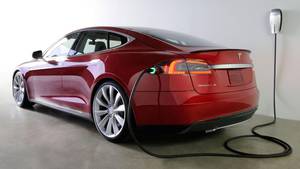Are electric cars up to scratch?
Interview with
One solution to the urban pollution problem is to switch to electric vehicles. But  what's the state of the technology and is the market ready for such a gear change? Peter Cowley invests in these technologies so he's been investigating their potential...
what's the state of the technology and is the market ready for such a gear change? Peter Cowley invests in these technologies so he's been investigating their potential...
Peter - The difference primarily of course is the drive train itself or the source of the energy, which for a petrol engine of course is a rotary engine which is generating from petrol And for electric, it's taking some battery source where it could be a chemical battery , it could be a fly wheel for regenerative, or it could be a capacitor and turning that into power which then drives the wheels. That's the main difference. The rest of the car, it remains basically the same.
Chris - To get the market to embrace this technology, there has to be easy provision of power and charging. If you look across just the UK at the moment, what does that look like in terms of provision of top ups?
Peter - Well, I have one at home which was subsidised by the government and there are a number around Cambridge. The smaller chargers, I think they're around about 10,000 in the UK at the moment. Most of those will be on people's private drives.
Chris - What about how long it takes to charge them up though because people don't want to spend years living at motorway service stations waiting for their cars to charge? They want to get from A to B as quickly as they can. So how long can these cars take or how long do they take to charge?
Peter - It's an interesting figure here. If I charge mine at home, which is not a 13 amp socket, but the one up, it charges at about 10 miles extra range per hour. However, if you charge them with one of these superchargers which Tesla have, you're charging it about 200 miles per hour. So for most people, it's just charging overnight, you're charging at work, it won't make any difference. It's only if you say, if you want to stop off on the way.
Chris - The thing that will determine whether a product is embraced by the market though, must be the cost effectiveness. So, when you work out the price in terms of buying the vehicle and then the price per mile travelled, what do the numbers look like?
Peter - At the moment, it costs me about 2 pence a mile on battery and it costs me about 12p a mile on petrol. Therefore, I got about 10p or so difference. In principle electric vehicles should be cheaper. At the moment, there's a government subsidy of exactly 5,000 pounds per car. So, I guess, the breakeven on electric vehicle is within the lifetime of using it sort of 6 to 7 years.
Chris - Now, cynics would say that are we not just pushing all the pollution into the countryside because you need a coal fired power station churning out current to charge up your electric cars. So instead of the pollution congregating in London, it's just bellowing out in Oxfordshire or something.
Peter - Yeah. They call it the long tail pipe. This is the tail pipe going back to the point of production. Two or three things saying, one, the particular pollution of course is ending up in the atmosphere, a long way from where the people are wondering around down Oxford Street. So, that's actually in a better place. But what the generation of this depends very much on the mix of energy whether it comes from renewables or not. In fact, funny enough, Paraguay is the best place to be in the world for this because almost all of it comes from hydroelectric. Australia and India are the worst. It's probably more efficiently produced as well. So in fact, you're moving the pollution away and you're producing less pollution. The other fact to take into account is the pollution generated by building the battery and recycling it because that is more than it would be for a petrol engine. So if you take the cradle to grave figure, it becomes a lot less exciting than if you're just taking the usage figure.










Comments
Add a comment